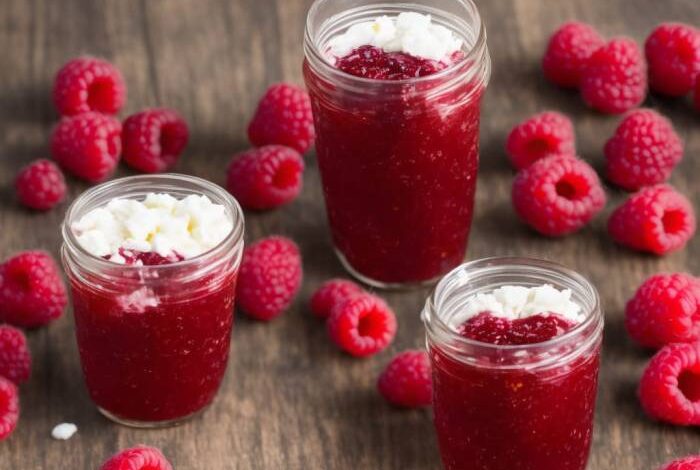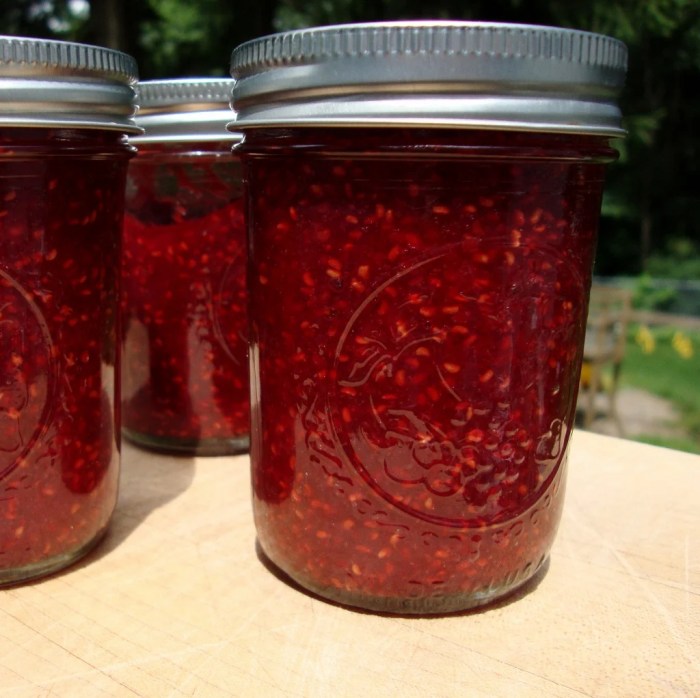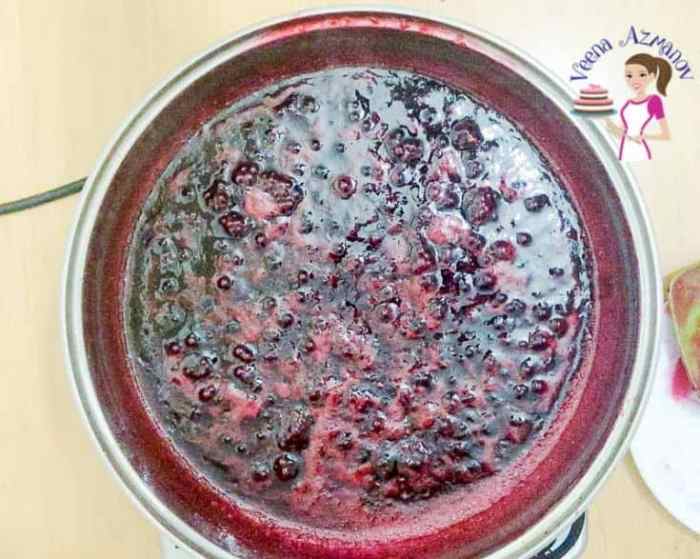
Raspberry Jam Without Pectin: A Deliciously Simple Guide
Raspberry jam without pectin – it sounds like a culinary paradox, doesn’t it? After all, pectin is the magical ingredient that transforms fruit into that luscious, jiggly jam we all know and love. But what if I told you that you could achieve that same deliciousness without relying on store-bought pectin?
It’s true! This post is your guide to crafting homemade raspberry jam using simple techniques and readily available ingredients.
From understanding the role of pectin to exploring various methods and tips for achieving the perfect consistency, we’ll delve into the world of pectin-free jam making. We’ll even uncover some flavor variations and creative serving ideas to make your homemade raspberry jam a culinary star.
Understanding Raspberry Jam Without Pectin
Raspberry jam without pectin is a delightful and natural way to enjoy the sweet and tart flavors of raspberries. While traditional jam recipes rely on pectin to achieve that thick, spreadable consistency, making jam without pectin requires a different approach.
Making raspberry jam without pectin is a fun challenge, especially when you want to capture the fresh, vibrant flavor of the berries. The key is to cook it down slowly, allowing the natural pectin in the raspberries to thicken the jam.
And speaking of sweet treats, have you tried strawberry cheesecake french toast ? It’s a delicious combination of creamy cheesecake and juicy strawberries, perfect for a weekend brunch. Just like the raspberry jam, the French toast is a testament to the beauty of simple, flavorful ingredients.
Let’s delve into the world of pectin-free raspberry jam and understand the nuances involved.
The Role of Pectin in Traditional Jam Making
Pectin is a natural substance found in fruits, particularly in the cell walls. It acts as a gelling agent, creating the desired texture in jams and jellies. When heated with sugar and acid, pectin forms a network that traps the liquid, resulting in a thick and spreadable consistency.
Benefits of Making Raspberry Jam Without Pectin
Making raspberry jam without pectin offers several advantages, including:
- Natural Flavor:Pectin can sometimes mask the natural flavors of the fruit. By omitting it, you allow the true taste of the raspberries to shine through.
- Reduced Sugar Content:Pectin often requires a higher sugar content to achieve the desired gel. Without pectin, you can use less sugar, resulting in a healthier and less sweet jam.
- Simple Ingredients:The absence of pectin simplifies the ingredient list, making it easier to find everything you need.
Challenges of Creating Jam Without Pectin
While pectin-free raspberry jam offers advantages, it also presents some challenges:
- Consistency:Achieving a thick and spreadable consistency without pectin can be tricky. Raspberries have a lower pectin content compared to other fruits, making it more challenging to achieve a gel.
- Longer Cooking Time:Without pectin to aid in gelling, the jam needs to be cooked for a longer time to allow the natural pectin in the raspberries to break down and thicken the mixture.
- Risk of Crystallization:Without the proper balance of sugar and acid, the jam can crystallize over time. This can be avoided by using a sugar-to-fruit ratio that is conducive to a stable jam.
Methods for Making Raspberry Jam Without Pectin
Raspberry jam without pectin is a delightful and easy-to-make treat that relies on the natural pectin found in the raspberries themselves. There are a few different methods for making raspberry jam without pectin, each with its own advantages and disadvantages.
Let’s delve into these methods.
Seedless Method
This method produces a smooth, seedless jam by straining the cooked raspberries through a fine-mesh sieve. This technique results in a jam with a delicate texture that is perfect for spreading on toast or using in baked goods.
- Ingredients:4 cups raspberries, 1 cup sugar
- Instructions:
- Combine raspberries and sugar in a saucepan and bring to a boil over medium heat, stirring occasionally.
- Reduce heat to low and simmer for 15-20 minutes, or until the jam thickens.
- Remove from heat and allow to cool slightly.
- Strain the jam through a fine-mesh sieve, pressing on the raspberries to extract as much juice as possible.
- Discard the seeds and transfer the strained jam to sterilized jars.
- Seal the jars tightly and store in a cool, dark place.
Freezer Method
This method is perfect for preserving the fresh flavor of raspberries and requires no cooking. Freezing the raspberries breaks down their cell walls, releasing their natural pectin and creating a jam-like consistency.
- Ingredients:4 cups raspberries, 1 cup sugar
- Instructions:
- Wash and hull the raspberries.
- Combine raspberries and sugar in a large bowl and stir until the sugar is dissolved.
- Transfer the mixture to freezer-safe containers, leaving about an inch of headspace.
- Freeze for at least 4 hours, or until the jam is solid.
- To use, thaw the jam in the refrigerator overnight.
Stovetop Method
This method involves cooking the raspberries and sugar together over low heat until the jam thickens. It’s a simple method, but it requires patience and attention to prevent the jam from burning.
- Ingredients:4 cups raspberries, 1 cup sugar
- Instructions:
- Combine raspberries and sugar in a saucepan and bring to a boil over medium heat, stirring occasionally.
- Reduce heat to low and simmer for 30-45 minutes, or until the jam thickens.
- To test for doneness, place a small amount of jam on a chilled plate. If the jam sets quickly, it’s ready.
- Remove from heat and allow to cool slightly.
- Transfer the jam to sterilized jars, seal tightly, and store in a cool, dark place.
Ingredients and Ratios

The key ingredients in raspberry jam without pectin are raspberries and sugar. While the exact ratio of raspberries to sugar can vary depending on the recipe and desired sweetness, a good starting point is a 1:1 ratio. This ratio provides a balanced sweetness and a good set.
However, you can adjust the sugar ratio to your preference, adding more sugar for a sweeter jam or less sugar for a more tart flavor.
Raspberry Jam Recipes: Ingredient Variations and Ratios
The following table compares different recipes for raspberry jam without pectin, showcasing ingredient variations and ratios. These variations can impact the texture and flavor of the final product.| Recipe | Raspberries (cups) | Sugar (cups) | Other Ingredients | Ratio (Raspberries:Sugar) ||————————————-|———————|—————|——————-|—————————-|| Simple Raspberry Jam | 4 | 4 |
| 1
1 || Seedless Raspberry Jam | 4 | 3 |
| 4
3 || Raspberry Jam with Lemon Juice | 4 | 4 | 1/4 cup lemon juice | 1:1 || Raspberry Jam with Vanilla Extract | 4 | 4 | 1 tsp vanilla extract | 1:1 |
Making raspberry jam without pectin can be a bit tricky, as it requires a lot of patience and careful attention to the cooking process. But it’s definitely worth it for that homemade, vibrant flavor. While I’m on the topic of simple recipes, I just have to share this easy basil pesto with almonds recipe I found recently.
It’s so quick and easy, and the result is a delicious, fragrant pesto that’s perfect for pasta, sandwiches, or even just a simple snack. Just like the raspberry jam, this pesto is a great way to showcase the natural flavors of fresh ingredients.
Using Ripe Raspberries
Using ripe raspberries is crucial for optimal flavor and texture. Ripe raspberries have a higher sugar content, which helps in the jam-making process. They also have a more intense flavor and a softer texture, leading to a smoother jam.
Underripe raspberries will result in a tart, less flavorful jam and a less smooth texture.
The Role of Sugar in Jam Making
Sugar plays a crucial role in jam making. It acts as a natural preservative, preventing spoilage by inhibiting the growth of bacteria. Sugar also helps to thicken the jam by drawing moisture from the raspberries, creating a gel-like consistency.
Additionally, sugar enhances the flavor of the raspberries, balancing their tartness and bringing out their sweetness.
Tips and Techniques
Making raspberry jam without pectin requires a bit more finesse to achieve the desired consistency. Here are some tips and techniques to help you create a delicious and set jam.
Achieving the Desired Consistency
To achieve the desired consistency in your jam, you need to understand how the sugar and fruit interact.
- Use a Jam Thermometer:A jam thermometer is essential for ensuring the jam reaches the correct setting point. This is the temperature at which the pectin in the fruit naturally gels, creating the desired consistency.
- Cook the Jam Properly:Cooking the jam for the correct amount of time is crucial for achieving the right consistency.
- Use a Ratio of Sugar to Fruit:The ratio of sugar to fruit is important for achieving the desired consistency.
- Test the Jam:To test if the jam is set, place a small amount on a chilled plate. If the jam sets quickly and wrinkles when you push it with your finger, it is ready.
Preventing Crystallization, Raspberry jam without pectin
Crystallization in jam can be a frustrating problem.
Making raspberry jam without pectin is all about harnessing the natural pectin in the berries, which means cooking it down longer to achieve that thick, spreadable consistency. While I was simmering my jam, I couldn’t help but think about the amazing depth of flavor you get in red ribbon roasted salsa , thanks to the slow roasting process.
Both methods, slow cooking and roasting, really bring out the best in the ingredients, creating something truly special. Just like the salsa, my raspberry jam without pectin will be a delicious homemade treat that I can’t wait to enjoy on toast or with yogurt.
- Use a High-Quality Sugar:Using a high-quality sugar, such as granulated sugar, is important for preventing crystallization.
- Add Acid:Adding an acid, such as lemon juice or citric acid, can help to prevent crystallization.
- Avoid Overheating:Overheating the jam can lead to crystallization.
Storing Raspberry Jam
Proper storage is essential for maintaining the quality of your jam.
- Use Sterilized Jars:Use sterilized jars to prevent spoilage.
- Seal Tightly:Seal the jars tightly to prevent air from getting in.
- Store in a Cool, Dark Place:Store the jam in a cool, dark place to prevent spoilage.
Flavor Variations and Enhancements

While the classic raspberry jam recipe is delicious on its own, there’s always room for creativity and experimentation. You can elevate your raspberry jam by adding other fruits, spices, or herbs, or by experimenting with different types of sugar. These additions not only enhance the flavor but also introduce new dimensions to the texture and overall appeal of the jam.
Flavor Combinations
Adding different fruits, spices, or herbs to your raspberry jam creates a symphony of flavors that can complement or contrast the natural tartness of raspberries.
- Additional Fruits:You can combine raspberries with other fruits like blackberries, blueberries, strawberries, or even peaches to create a multi-fruit jam. For instance, a raspberry-blackberry jam offers a richer, more complex flavor profile, while a raspberry-peach jam provides a delicate sweetness with a hint of stone fruit aroma.
- Spices:Incorporating spices like cinnamon, ginger, cardamom, or star anise can add warmth and complexity to your raspberry jam. A pinch of cinnamon can create a comforting and familiar flavor, while a touch of ginger adds a spicy kick. Cardamom and star anise, when used sparingly, can impart a subtle, exotic aroma.
- Herbs:Certain herbs like mint, basil, or rosemary can surprisingly enhance the flavor of raspberry jam. A sprig of mint can add a refreshing coolness, while basil adds a subtle savory note that balances the sweetness. Rosemary, when used sparingly, can impart a subtle woodsy aroma.
Sugar’s Impact on Flavor
The type of sugar used in your raspberry jam significantly impacts its flavor profile.
- Granulated Sugar:The most common type of sugar used in jam making, granulated sugar provides a clean, sweet flavor that allows the natural raspberry flavor to shine through.
- Brown Sugar:Brown sugar adds a caramel-like sweetness and a touch of molasses flavor to the jam, creating a more complex and nuanced taste.
- Honey:Honey imparts a unique floral sweetness and a slightly thicker texture to the jam, adding a touch of sophistication. However, honey can also caramelize more easily during cooking, so it’s important to monitor the jam carefully.
- Maple Syrup:Maple syrup provides a rich, buttery sweetness and a hint of caramel flavor to the jam, making it a delicious alternative to sugar.
Enhancing Flavor and Texture
Incorporating additional ingredients like lemon juice or vanilla extract can elevate the flavor and texture of your raspberry jam.
- Lemon Juice:A squeeze of lemon juice adds a bright acidity that balances the sweetness of the jam and enhances the overall flavor. It also helps to prevent the jam from crystallizing and maintains a smooth texture.
- Vanilla Extract:A dash of vanilla extract adds a warm, comforting aroma and a subtle sweetness to the jam. It complements the raspberry flavor and creates a more complex and well-rounded taste.
Serving and Enjoyment: Raspberry Jam Without Pectin

Homemade raspberry jam without pectin is a versatile treat that can be enjoyed in countless ways, from classic breakfast spreads to creative dessert fillings and even savory sauces. Its natural sweetness and vibrant flavor make it a delightful addition to any meal or occasion.
Creative Serving Ideas
This jam’s versatility allows it to be enjoyed in various ways beyond traditional toast. Here are some creative serving ideas:
- Desserts:
- Raspberry Swirl Cheesecake:This recipe involves swirling the jam into a classic cheesecake batter for a beautiful and delicious twist.
- Raspberry Jam Filled Cookies:Use the jam as a filling for classic sugar cookies or chocolate chip cookies.
- Raspberry Jam Tarts:Bake mini tarts and fill them with the jam, topped with whipped cream or a dollop of vanilla ice cream.
- Breakfast Dishes:
- Raspberry Jam and Yogurt Parfaits:Layer yogurt, granola, and raspberry jam in a glass for a healthy and satisfying breakfast.
- Raspberry Jam French Toast:Add a generous dollop of jam to your French toast for a sweet and fruity twist.
- Raspberry Jam Pancakes:Spread a generous amount of jam on top of your pancakes for a delightful breakfast treat.
- Savory Applications:
- Raspberry Jam Glaze for Roasted Chicken:Brush the chicken with a mixture of raspberry jam, honey, and balsamic vinegar for a sweet and tangy glaze.
- Raspberry Jam BBQ Sauce:Combine the jam with ketchup, brown sugar, and spices for a unique BBQ sauce to use on grilled meats or vegetables.
- Raspberry Jam and Goat Cheese Crostini:Spread a mixture of goat cheese and raspberry jam on toasted baguette slices for a sophisticated appetizer.
Table Setting Ideas
A visually appealing table setting can enhance the enjoyment of your homemade raspberry jam. Consider the following:
- Serving Vessel:A small, elegant glass jar or a vintage ceramic dish can add a touch of charm to the table setting.
- Accompaniments:Offer a selection of breads, crackers, or even fresh fruit slices to complement the jam.
- Color Palette:Choose a color scheme that complements the vibrant red of the raspberry jam, such as white, cream, or light green.
- Floral Touches:A small bouquet of fresh flowers or a sprig of rosemary can add a touch of elegance and fragrance.
“A beautifully set table can elevate the simplest of meals, and a homemade raspberry jam adds a touch of homemade love and warmth to any occasion.”

